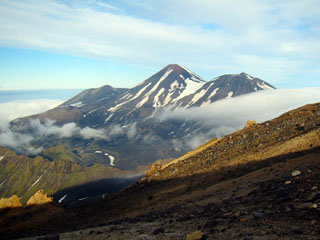Report on Tanaga (United States) — 8 March-14 March 2023
Smithsonian Institution / US Geological Survey
Weekly Volcanic Activity Report, 8 March-14 March 2023
Managing Editor: Sally Sennert.
Please cite this report as:
Global Volcanism Program, 2023. Report on Tanaga (United States) (Sennert, S, ed.). Weekly Volcanic Activity Report, 8 March-14 March 2023. Smithsonian Institution and US Geological Survey.
Tanaga
United States
51.885°N, 178.146°W; summit elev. 1806 m
All times are local (unless otherwise noted)
AVO reported that earthquake activity near Tanaga began to increase on 4 March with events up to the M2 range and located 9-18 km deep. Seismicity again increased around 1330 on 7 March and by 2045 earthquakes were occurring at a rate of 2-3 per minute. AVO raised the Aviation Color Code to Yellow (the second lowest level on a four-color scale) and the Volcano Alert Level to Advisory the second lowest level on a four-level scale). The seismicity was sustained during 8-9 March and had shallowed to depths less than about 6 km, indicating increased potential for an eruption. AVO raised the Volcano Alert Level to Watch and the Aviation Color Code to Orange, the highest levels, at 1719 on 9 March. Seismicity was also elevated at Takawangha, 8 km E; both volcanoes are located on Tanaga Island. It was uncertain which volcano would erupt, if an eruption were to occur, so the Volcano Alert Level and Aviation Color Code for Takawangha were also raised to the same level. Earthquakes beneath Tanaga Island occurred at a rate of up to several per minute, with the largest event during 8-9 March, a M3.9, located under Tanaga Volcano. Earthquakes beneath Tanaga and Takawangha occurred at a rate of up to several events per minute during 10-11 March and at a slightly reduced rate during 12-14 March. The earthquakes had magnitudes up to around 4.
Geological Summary. Tanaga volcano, the second largest volcanic center of the central Aleutians, is the central and highest of three youthful stratovolcanoes oriented along a roughly E-W line at the NW tip of Tanaga Island. Ridges to the east and south represent the rim of an arcuate caldera formed by collapse of an edifice during the Pleistocene. Most Holocene eruptions originated from Tanaga volcano itself, which consists of two large cones, the western of which is the highest, constructed within a caldera whose 400-m-high rim is prominent to the SE. At the westernmost end of the complex is conical Sajaka, a double cone that may be the youngest of the three volcanoes. Sajaka One volcano collapsed during the late Holocene, producing a debris avalanche that swept into the sea, after which the Sajaka Two cone was constructed within the collapse scarp.
Source: US Geological Survey Alaska Volcano Observatory (AVO)

